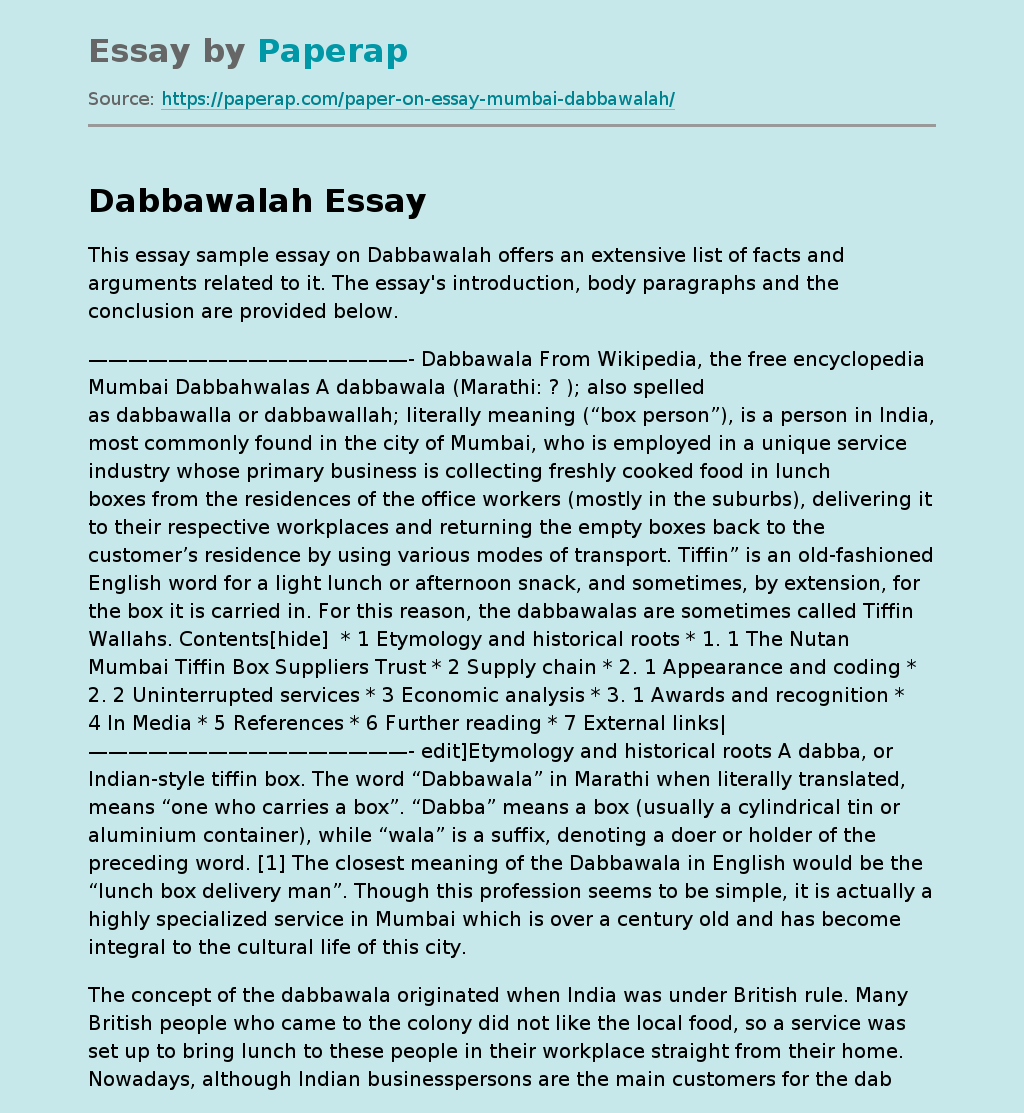The Concept of Dabbawala and India Under British Rule
This essay sample essay on Dabbawalah offers an extensive list of facts and arguments related to it. The essay’s introduction, body paragraphs and the conclusion are provided below.
This is usually done for a monthly fee of about 450 Indian rupees. The meal is cookedin the morning and sent in lunch boxes carried by dabbawalas, who have a complex association and hierarchy across the city. Dabbawalas in action at a Mumbai Suburban Railway station. A collecting dabbawala, usually on bicycle, collects dabbas either from a worker’s home or from the dabba makers.
As many of the carriers are illiterate, the dabbas have some sort of distinguishing mark on them, such as a colour or group of symbols.
The dabbawala then takes them to a designated sorting place, where he and other collecting dabbawalas sort (and sometimes bundle) the lunch boxes into groups. The grouped boxes are put in the coaches of trains, with markings to identify the destination of the box (usually there is a designated car for the boxes).
The markings include the railway station to unload the boxes and the building address where the box has to be delivered. At each station, boxes are handed over to a local dabbawala, who delivers them. The empty boxes are collected after lunch or the next day and sent back to the respective houses. Appearance and coding Markings: abbreviations for collection points, colour code for starting station, number for destination station and markings for handling dabbawala at destination, building and floor.
A typical dabbawala lunch. It was estimated in 2007 that the dabbawala industry was still growing by 5-10% per annum. Although the service remains essentially low-tech, with the delivery men as the prime movers, the dabbawalas have started to embrace technology, and now allow tanuj wadhi for delivery through SMS. An on-line poll on the web site ensures that customer feedback is given pride of place. The success of the system depends on teamwork and time management. Such is the dedication and commitment of the barely literate and barefoot delivery men (there are only a few delivery women) who form links in the extensive delivery chain, that there is no system of documentation at all. A simple colour-coding system doubles as an ID system for the destination and recipient. There are no multiple elaborate layers of management either — just three layers.
Each dabbawala is also required to contribute a minimum capital in kind, in the form of two bicycles, a wooden crate for the tiffins, white cotton kurta-pyjamas, and the white trademarkGandhi cap (topi). The return on capital is ensured by monthly division of the earnings of each unit. Uninterrupted services The service is almost always uninterrupted, even on the days of severe weather such as monsoons. The local dabbawalas and population know each other well, and often form bonds of trust.
Dabbawalas are generally well accustomed to the local areas they cater to, and use shortcuts and other low profile routes to deliver their goods on time. Occasionally, people communicate between home and work by putting messages inside the boxes; however, with the rise of instant communication such as SMS and instant messaging, this trend is vanishing. Since 1890 ,the year in which the Dabbawalas formally came into existence ,none of its members had ever gone on a strike.
This trend was broken in 2011 when the members decided to head towards Azad Maidan to support Anna Hazare in his campaign against corruption. Economic analysis Each dabbawala, regardless of role, gets paid about eight thousand rupees per month. In 1998, Forbes Magazine found its reliability to be that of a six sigma standard. This implies that the Dabbawalas make less than one mistake in every 6 million deliveries, despite most of the delivery staff being illiterate. 7] More than 175,000 to 200,000 lunch boxes get moved every day by an estimated 4,500 to 5,000 dabbawalas, all with an extremely small nominal fee and with utmost punctuality. The BBC has produced a documentary on dabbawalas[citation needed] and Prince Charles, during his visit to India, visited them (he had to fit in with their schedule, since their timing was too precise to permit any flexibility). Prince Charles also invited them to his wedding withCamilla Parker Bowles in London on 9 April 2005.
Owing to the tremendous publicity, some of the dabbawalas were invited to give guest lectures in some of the top business schools of India, which is very unusual. Most remarkably in the eyes of many Westerners, the success of the dabbawala trade has involved no advanced technology, except for trains (and as mentioned above, SMS services for booking). The New York Times reported in 2007 that the 125-year-old dabbawala industry continues to grow at a rate of 5–10% per year. Awards and recognition ISO 9001:2000 certified by the Joint Accreditation System of Australia and New Zealand In Media On 28 December 2011, the British series, “Top Gear” broadcasted the episode “India Special” where Clarkson, Hammond, and May travel to India for a “trade mission”. In Mumbai, they aimed to beat the efficiency of the dabbawala by using a car instead of a train. The mission fails when Clarkson, in a rush to beat the train, did not take enough cargo, leaving Hammond to carry Clarkson’s load as well as his own.
The Concept of Dabbawala and India Under British Rule. (2019, Dec 07). Retrieved from https://paperap.com/paper-on-essay-mumbai-dabbawalah/

